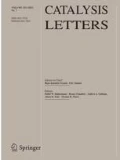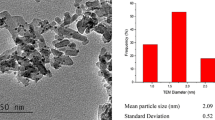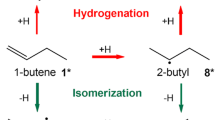Abstract
The role of particle size during the hydrogenation/dehydrogenation of cyclohexene (10 Torr C6H10, 200–600 Torr H2, and 273–650 K) was studied over a series of monodisperse Pt/SBA-15 catalysts. The conversion of cyclohexene in the presence of excess H2 (H2: C6H10 ratio = 20:60) is characterized by three regimes: hydrogenation of cyclohexene to cyclohexane at low temperature (<423 K), an intermediate temperature range in which both hydrogenation and dehydrogenation occur; and a high temperature regime in which the dehydrogenation of cyclohexene dominates (>573 K). The rate of both reactions demonstrated maxima with temperature, regardless of Pt particle size. For the hydrogenation of cyclohexene, a non-Arrhenius temperature dependence (apparent negative activation energy) was observed. Hydrogenation is structure insensitive at low temperatures, and apparently structure sensitive in the non-Arrhenius regime; the origin of the particle-size dependent reactivity with temperature is attributed to a change in the coverage of reactive hydrogen. Small particles were more active for dehydrogenation and had lower apparent activation energies than large particles. The selectivity can be controlled by changing the particle size, which is attributed to the structure sensitivity of both reactions in the temperature regime where hydrogenation and dehydrogenation are catalyzed simultaneously.





Similar content being viewed by others
Notes
The hydrogenation of cyclohexene at low temperatures is thermodynamically preferred, while dehydrogenation dominates at high temperature, and the switch between preferential hydrogenation and dehydrogenation occurs over a very narrow temperature range. Reaction temperatures of 400 K favor hydrogenation (K h/K d = 107), while 600 K favors dehydrogenation (K h/K d = 10−2).
The influence of particle size on the coverage of hydrogen is complicated due to the presence of multiple hydrogen species on a Pt surface as demonstrated in temperature-programed desorption (TPD) studies. If only a single population of adsorbed hydrogen is present on the surface, the effect is simply one of low surface coverage. However, if there are various populations of adsorbed hydrogen on the surface of the nanoparticle, the particle size dependence may be a result of the inability of one particle size to support a particular population (sub-species) of adsorbed hydrogen under reaction conditions.
The entire Pt/SBA-15 series demonstrates an increase in rate (and a corresponding change in hydrogenation–dehydrogenation selectivity) with increasing hydrogen pressure. The dependence of the rate of hydrogenation was highly sensitive to the partial pressure of hydrogen over the 400 K interval shown in Fig. 4.
References
Che M, Bennett CO (1989) Adv Catal 36:55
Boudart M (1969) Adv Catal 20:153
Rioux RM, Song H, Hoefelmeyer JD, Yang P, Somorjai GA (2005) J Phys Chem B 109:2192
Song H, Rioux RM, Hoefelmeyer JD, Komor R, Niesz K, Grass M, Yang P, Somorjai GA (2006) J Am Chem Soc 128:3027
Segal E, Madon RJ, Boudart M (1978) J Catal 52:45
Dorling TA, Moss RL (1966) J Catal 5:111
Davis SM, Somorjai GA (1980) J Catal 65:78
McCrea KR, Somorjai GA (2000) J Mol Catal A Chem 163:43
Sermon PA, Georgiades G, Vong MSW, Martin-Luengo MA, Reyes PN (1987) Proc R Soc Lond A 410:353
O’Rear DJ, Löffler DG, Boudart M (1985) J Catal 94:225
Cogen JM, Ezaz-Nikpay K, Fleming RH, Baumann SM, Maier WF (1987) Angew Chem Int Ed Engl 26:1182
Molnár É, Tasi G, Kónya Z, Kiricsi I (2005) Catal Lett 101:159
Zaera F (2002) J Phys Chem B 106:4043
Mohr C, Hofmeister H, Claus P (2003) J Catal 213:86
Mohr C, Hofmeister H, Radnik J, Claus P (2003) J Am Chem Soc 125:1905
Vannice MA, Sen B (1989) J Catal 115:65
Somorjai GA, Rioux RM (2005) Catal Today 100:201
Kim JM, Han YJ, Chmelka BF, Stucky GD (2000) Chem Commun 2437
Singh UK, Vannice MA (2000) J Catal 191:165
Rioux RM, Komor R, Song H, Hoefelmeyer JD, Grass M, Niesz K, Yang P, Somorjai GA (2008) J Catal 254:1
Deitz WA (1967) J Gas Chromatogr 5:68
Fási A, Pálinkó I, Katona T, Bartók M (1997) J Catal 167:215
Paál Z (1985) J Catal 91:181
Yoon KJ, Vannice MA (1983) J Catal 82:457
Orozco JM, Webb G (1983) Appl Catal 6:67
Wootsch A, Paál Z (1999) J Catal 185:192
Wootsch A, Paál Z (2002) J Catal 205:86
Bond GC, Slaa JC (1994) Catal Lett 23:293
Bond GC, Slaa JC (1995) J Mol Catal A Chem 98:81
Yang M, Rioux RM, Somorjai GA (2006) J Catal 237:255
Bratlie KM, Flores LD, Somorjai GA (2005) Surf Sci 599:93
Sen B, Vannice MA (1991) J Catal 130:9
McCabe RW, Schmidt LD (1976) Surf Sci 60:85
McCabe RW, Schmidt LD (1977) Surf Sci 65:189
Vong MSW, Sermon PA (1987) J Chem Soc Faraday Trans 83:1369
Parera JM, Figoli NS, Traffano EM, Beltramini JN, Martinelli EE (1983) Appl Catal 5:33
Vong MSW, Sermon PA (1987) J Chem Soc Faraday Trans 83:1667
Janz GJ (1954) J Chem Phys 22:751
Acknowledgments
This work was supported by the Director, Office of Science, Office of Advanced Scientific Computing Research, Office of Basic Energy Sciences, Chemical Sciences, Geosciences, and Biosciences Division, of the U.S. Department of Energy under Contract No. DE-AC02-05CH11231. R.M.R. acknowledges the Ford Motor Company for financial support through a graduate fellowship administered by the Berkeley Catalysis Center. The authors acknowledge our long term collaboration with Professor Peidong Yang of the Department of Chemistry at the University of California, Berkeley. The authors would also like to acknowledge Professor M. A. Vannice of the Pennsylvania State University for donation of the 3.2% Pt/SiO2 material and Dr. Samrat Mukherjee for its preparation.
Author information
Authors and Affiliations
Corresponding author
Appendix I. Deviations from Thermodynamic Selectivity at High Temperatures: Influence of Hydrogen Coverage and Surface Reaction Segregation
Appendix I. Deviations from Thermodynamic Selectivity at High Temperatures: Influence of Hydrogen Coverage and Surface Reaction Segregation
The thermodynamics of cyclohexene hydrogenation are favored at low temperatures (ΔG h = −18 kcal mol−1 at 298 K), while the dehydrogenation is favored at high temperatures (ΔG d = −11 kcal mol−1 at 600 K) [37]. The thermodynamic selectivity, defined as \( \frac{{K_{\text{h}} }}{{\left( {K_{\text{h}} + K_{\text{d}} } \right)}} \), where K h and K d are the respective equilibrium constants (and related to the free-energy of reaction, \( K = exp\left( {\frac{{ - \Updelta G_{{{\text{h or}} {\text{d}}}} }}{\text{RT}}} \right) \) for hydrogenation and dehydrogenation is plotted as the solid line in Fig. 6. The free-energy reaction data was obtained from [38]. At 400 ≤ T ≤ 450 K, the experimentally-measured selectivity for hydrogenation is lower than the thermodynamic selectivity for most samples, although a few of the low-temperature experimentally-measured selectivity data was greater than the thermodynamic value. This is attributed to error in the measurement of the individual reaction rates in this regime where the dehydrogenation activity is low. Figure 6a demonstrates the selectivity for cyclohexane predicted by thermodynamics is much greater than the experimentally-measured values at temperatures >450 K for all catalysts (supported and single crystal). The deviation in this temperature range is related to a much larger decrease in the rate of hydrogenation over this temperature range (see Fig. 1a, the rate of hydrogenation actually decreases with increasing temperature) than the rate of dehydrogenation which has begun to plateau (Fig. 1b). The overall trend of increased hydrogenation selectivity on catalysts containing larger particles is apparent over the entire temperature range as discussed in Sect. 3.2 and demonstrated in Fig. 3. Due to the fact that cyclohexane selectivity is lower than the thermodynamic selectivity, the benzene selectivity will be correspondingly greater than the thermodynamic selectivity (Fig. 6b). For all but a few data points, the selectivity to benzene is greater than that predicted by thermodynamics.
The selectivity to (a) cyclohexane and (b) benzene over a number of catalysts: (●) 3.2% Pt(1 nm)/SiO2; (□) 0.6% Pt(1.7 nm)/SBA-15; (▲) 0.77% Pt/(2.9 nm)/SBA-15; (○) 0.6% Pt(3.6 nm)/SBA-15; and ( ) 0.62% Pt(7.1 nm)/SBA-15, (★) Pt(111) and (✩) Pt(100) single crystal surfaces [8]. The solid line represents the thermodynamic selectivity, based on the temperature dependent Gibbs free-energy (ΔG
rxn(T)) of both hydrogenation and dehydrogenation reactions [38]. The points in (a) that lie above the thermodynamic selectivity represent typical uncertainties in the rate measurements, while the points in (b) lie above the thermodynamic selectivity line because the decreased hydrogenation rate leads to a selectivity in benzene greater than that predicted by thermodynamics. The reaction conditions were 10 Torr C6H10, 200 H2 Torr and the temperature stated on the x-axis
) 0.62% Pt(7.1 nm)/SBA-15, (★) Pt(111) and (✩) Pt(100) single crystal surfaces [8]. The solid line represents the thermodynamic selectivity, based on the temperature dependent Gibbs free-energy (ΔG
rxn(T)) of both hydrogenation and dehydrogenation reactions [38]. The points in (a) that lie above the thermodynamic selectivity represent typical uncertainties in the rate measurements, while the points in (b) lie above the thermodynamic selectivity line because the decreased hydrogenation rate leads to a selectivity in benzene greater than that predicted by thermodynamics. The reaction conditions were 10 Torr C6H10, 200 H2 Torr and the temperature stated on the x-axis
Significant deviations of kinetic selectivity from thermodynamic selectivity has been documented previously for this reaction [9]. The authors suggested that both reactions surface segregate to specific sites on the nanoparticle surface [9]. Cyclohexene dehydrogenates preferentially at low coordination sites (which are more prevalent on smaller particles and consistent with particle-size dependent data (see Table 1)), and the adsorbed hydrogen diffuses away from low coordination sites to higher-coordination sites where it desorbs (\( 2 {\text{H}}^{*} \rightleftharpoons {\text{H}}_{ 2} \left( {\text{g}} \right) + 2^{*} \)) immediately or reacts with cyclohexene adsorbed at high coordination sites to form cyclohexane. The hydrogen at the high coordination sites in the presence of adsorbed cyclohexane may represent the high temperature population observed in H2-TPD studies [35]. The equilibrium occurs in isolation, effectively separating adsorbed hydrogen and hydrocarbon, allowing non-equilibrium yields of benzene. Sermon and co-workers propose that under conditions where both cyclohexene hydrogenation and dehydrogenation occur on the same surface, the two reaction pathways segregate [9]. This picture is consistent with the cyclohexene hydrogenation rate and the observed changes in selectivity with particle size (see Figs. 2 and 3, respectively).
Rights and permissions
About this article
Cite this article
Rioux, R.M., Hsu, B.B., Grass, M.E. et al. Influence of Particle Size on Reaction Selectivity in Cyclohexene Hydrogenation and Dehydrogenation over Silica-Supported Monodisperse Pt Particles. Catal Lett 126, 10–19 (2008). https://doi.org/10.1007/s10562-008-9637-8
Received:
Revised:
Accepted:
Published:
Issue Date:
DOI: https://doi.org/10.1007/s10562-008-9637-8





